AMMAN — Back pain is a prevalent global issue. Around 60–70
percent of people will experience back pain, most frequently lower back pain,
during their lifetime. Most experience this back pain in early adulthood.
Recently there has been an increase in back pain amongst children and
adolescents.
اضافة اعلان
For mild cases, methods to alleviate back pain include
over-the-counter painkillers such as Panadol (Paracetamol) or Nopain
(Naproxen).
For more severe cases, especially cases where the pain
radiates down to the legs, epidural corticosteroid injections are used for 3
months. While these methods help treat pain as a symptom of back pain,
unfortunately, they do not fix the cause. Alternative approaches to treating
back pain from the root cause focus on physical therapy, rehabilitation, and
spinal manipulation.
Types of back
pain
The spine is a complex series of joints packed full of
nerve endings. It's responsible for carrying a large percentage of the body's
weight, especially when standing or sitting upright. Due to its plethora of
functions, the spine faces an increased threat of possible issues.
Mechanical pain is the most common type of lower back
pain; it results from problems involving the muscles, ligaments, joints, or
bones in or around the spine. Typically, the pain is contained to the lower
back and buttocks, but it could affect the top of the legs. This type of pain
is primarily influenced by the amount of weight and strain that your back
absorbs during static and active movements.
Muscle strains and ligament sprains are the most common
injuries which cause this pain. Strains are the damage inflicted on muscles due
to overstretching and tears. Sprains occur in the ligaments. Common causes for
strains and sprains include lifting heavy objects, sudden movements that put
stress on the back, and long-term poor posture. In addition, the pain can be
triggered by specific actions.
Who's at risk
The cause of lower back pain, especially mechanical pain,
is multifactorial. Back pain can come without warning and may be of no fault of
your own. Despite this, some factors will put you at greater risk for
developing back pain. When referring to mechanical back pain, risk factors
include age, pain is more common in adults, lack of exercise, pain can happen
as a result of underdeveloped, weakened, or unused muscles in the back or
abdomen, excess weight, the spine is placed under more stress when carrying
extra weight, improper lifting techniques, pain is caused when individuals lift
with the back instead of the legs, and finally, psychological conditions,
evidence suggests that individuals with depression and anxiety are at greater
risk of developing back pain.
Exercises that
can help alleviate back pain
All forms of exercise have been shown to help in
relieving back pain. By strengthening the muscles that support the spine,
pressure will be alleviated of the spine. Exercise can also help reduce
stiffness and improve mobility, allowing for better blood circulation and
nutrients throughout the body, including the spine. Furthermore, exercise
causes the release of a hormone called endorphins, which improves mood and
relieves depressive symptoms.
There are specific exercises designed to improve back
pain. Before discussing these exercises, it is essential to note that
individuals should consult with their doctors before performing any activities
to ensure that they are done safely and correctly. Exercising after spinal
surgery or if you have a serious spinal condition can increase the risk of
pain. Stop the exercise immediately if you begin to feel increasing pain,
tingling, or numbness in one or both legs. When it comes to back pain, powering
through exercises and ignoring pain can cause serious injury.
One of the most popular exercise methods is the McKenzie
method which consists of 8 steps.
Step 1: Laying on your stomach
The purpose is to reduce pressure on the lower back while
also realigning the spine. First, lie down flat on your stomach with your arms
to your side. Then, you can either face down or turn your face to the side.
Hold this position for 2-3 minutes and repeat up to 8 times a day.
 Step 2:
Step 2: Lying on a pillow
The second step is meant to support the lower back. Follow
the same technique as step 1 but add a pillow under your stomach and hips. Hold
for 2-3 and repeat up to 8 times a day.
 Step 3:
Step 3: Lying on your elbows
The purpose of step 3 is to help
restore the natural curve to your lower back. First, start by lying on your
stomach and prop yourself on your elbows with your palms flat against the
ground. Make sure your shoulders are in line with your elbows, forming a
90-degree angle. Hold for 2-3 minutes and repeat up to 8 times a day.
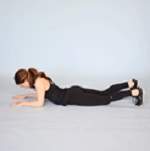 Step 4:
Step 4: Prone press-ups
This step helps to restore the
natural curve of the spine further. While lying down on your stomach, place
your hands under your shoulders. Slowly begin to straighten out your elbows and
lift your upper body. Hold the extended position for 2 seconds and slowly
return to the starting position — complete 10 repetitions up to 8 times a day.
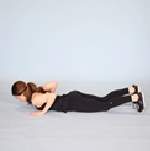
 Step 5:
Step 5: Standing Extensions
This step helps improve backward mobility of the spine,
especially in the lower back. Start by standing straight up and place your
hands along the length of your lower back. Then, with the support of your hands
and keeping your knees straight, slowly lean back as far as possible and hold
for 2 seconds before returning to the starting position — complete 10
repetitions and repeat up to 8 times a day.

 Step 6:
Step 6: Lying flexion
This is the first step in restoring forward mobility in the
lower back and helps regain the overall range of motion. For this step, make
sure to be lying on a firm, comfortable mat but not too hard. To start, lie
down on your back with your feet flat on the ground and hip-width apart.
Then, while keeping your shoulders and tailbone against the
ground, slowly bring your knees to your chest using your arms. Hold this
position for 2 seconds and slowly return to the starting position — complete 6
repetitions and repeat up to 4 times a day.

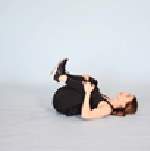 Step 7:
Step 7: Sitting flexion
This is an intermediate version of step 6 and further
restores mobility. Start by sitting on the edge on a seat with your back
straight and feet a little more than shoulder-width apart, flat on the floor.
Next, reach forward and try to place your hands flat on the
floor in between your feet. Hold for 2 seconds before returning to the starting
position — complete 6 repetitions up to 4 times a day.
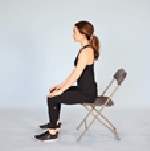
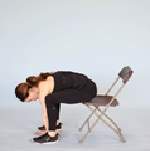 Step 8:
Step 8: Standing flexion
This is the last and most advanced step to restoring forward
mobility. Start by standing with your feet shoulder-width apart and slowly bend
forwards at the hip while trying to keep your knees straight.
Next, try to reach the floor and place your hands flat. This
may not be possible at first, but your flexibility and range of motion will
improve over time. Hold for 2 seconds and slowly return to the starting
position — complete 6 repetitions up to 2 times a day.
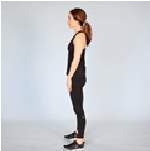
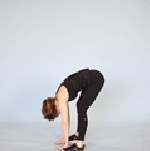 Finding help in
Jordan
Finding help in
Jordan
Back pain is a severe burden to quality of life. These
exercises may improve some of the symptoms or causes of back pain, but they
might not heal the cause.
To get help, you can visit the Khan Kinetic Treatment
Orthopedic Spine Center located in Sweileh, Amman. The center aims
to provide treatment and diagnostics for back pain. They use highly
sophisticated technology and non-invasive procedures to realign the spine and
help regenerate tissue painlessly.
Read more Health
Sources:
https://www.who.int/medicines/areas/priority_medicines/Ch6_24LBP.pdf
https://www.uofmhealth.org/health-library/abk1059
https://www.spine-health.com/conditions/lower-back-pain/lower-back-pain-symptoms-diagnosis-and-treatment
https://www.mayoclinic.org/diseases-conditions/back-pain/symptoms-causes/syc-20369906
https://www.spine-health.com/wellness/exercise/exercise-and-back-pain
https://www.healthline.com/health/mckenzie-exercises#prone-press-ups
https://kktjordan.com/
Photos from:
https://www.healthline.com/health/mckenzie-exercises#prone-press-ups




